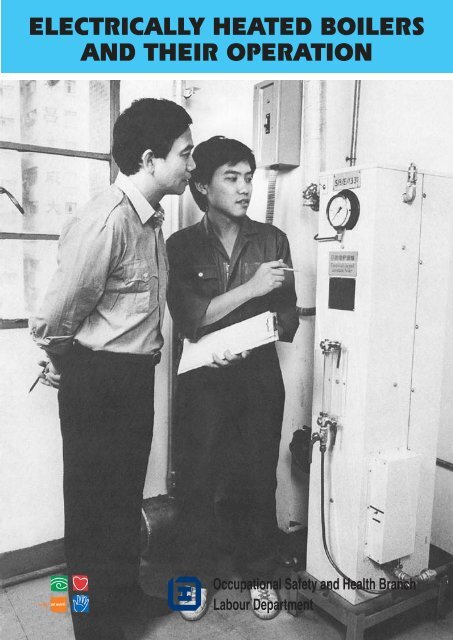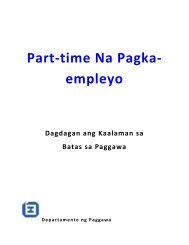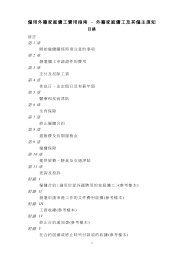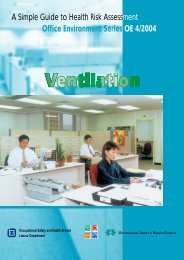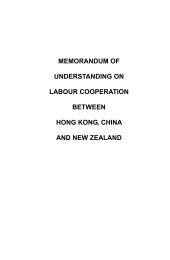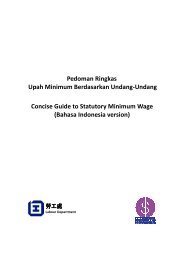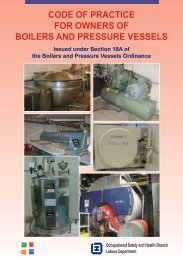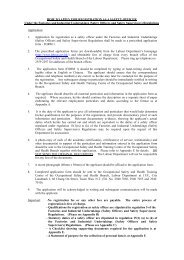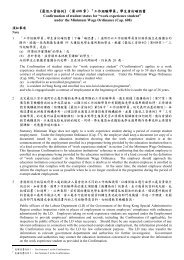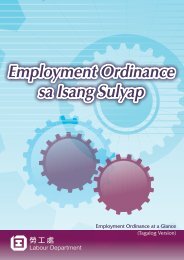Electrically Heated Boilers and Their Operation
Electrically Heated Boilers and Their Operation
Electrically Heated Boilers and Their Operation
You also want an ePaper? Increase the reach of your titles
YUMPU automatically turns print PDFs into web optimized ePapers that Google loves.
ELECTRICALLY HEATED BOILERS<br />
AND THEIR OPERATION
ELECTRICALLY HEATED BOILERS AND THEIR OPERATION<br />
Owners of electrically heated boilers must<br />
take note of the following when using the<br />
boilers:<br />
The boilers must be registered with the<br />
<strong>Boilers</strong> <strong>and</strong> Pressure Vessels Division<br />
(BPVD) of the Labour Department (LD).<br />
The boilers must be inspected<br />
periodically for safe operation.<br />
All boilers must be issued with valid<br />
certificates of fitness.<br />
The operation of the boilers must be<br />
under the direct supervision of a<br />
competent person.<br />
Registration <strong>and</strong> Examination<br />
The owner must apply to the BPVD of the LD<br />
for registration of the boiler, <strong>and</strong> to obtain a<br />
registration number, at least 30 days before<br />
putting the boiler into operation.<br />
Before a boiler is put into use, the boiler <strong>and</strong> its<br />
accessories must be inspected by an appointed<br />
examiner. The safety valve must be properly<br />
sealed <strong>and</strong> a certificate of fitness is required.<br />
The boiler must be properly maintained <strong>and</strong><br />
inspected by an appointed examiner every 14<br />
months. Re-issuance of a certificate of fitness<br />
is required. Operating a boiler without a valid<br />
certificate of fitness is an offence <strong>and</strong> the owner<br />
on conviction is liable to a maximum fine of<br />
HK$50,000.<br />
Competent Person<br />
An operating boiler will generate high-pressure<br />
steam. If the boiler is not properly managed<br />
<strong>and</strong> maintained, it can lead to serious accidents<br />
with loss of lives <strong>and</strong> property. Therefore, the<br />
<strong>Boilers</strong> <strong>and</strong> Pressure Vessels Ordinance<br />
(BPVO) stipulates that only a competent person<br />
issued with a certificate of competency by the<br />
BPVD of the LD is eligible for operating boilers.<br />
2<br />
10<br />
8<br />
Under Section 49 of the BPVO, operating a boiler<br />
without the direct supervision of a competent<br />
person is an offence. The owner is liable to be<br />
prosecuted subject to a fine up to HK$50,000.<br />
<strong>Electrically</strong> <strong>Heated</strong> <strong>Boilers</strong> <strong>and</strong><br />
their major accessories<br />
<strong>Electrically</strong> heated boilers use electric heating coils<br />
to boil water into high-pressure steam. This kind<br />
C<br />
3<br />
1<br />
7<br />
A<br />
4<br />
11<br />
B<br />
5<br />
9<br />
6<br />
1<br />
2<br />
3<br />
4<br />
5<br />
6<br />
7<br />
8<br />
9<br />
10<br />
11<br />
Pressure Gauge<br />
Safety Valve<br />
Stop Valve<br />
Water Gauge<br />
Feed Water Valve<br />
Drain Valve<br />
Bleed Air Valve<br />
Heating Coil<br />
Mud Hole / Cover<br />
Pressure Control<br />
switch<br />
Automatic Water<br />
Level Controller<br />
Automatically Controlled Filament Type Electric Steam Boiler
of boilers can be classified into the automatically<br />
controlled <strong>and</strong> the manually controlled types.<br />
Basically, the designs are similar with some<br />
common types of accessories, such as the safety<br />
valve, pressure gauge, water gauge, valves,<br />
pressure switch <strong>and</strong> low water level alarm.<br />
The main difference between the two types of<br />
boilers is that the automatically controlled boiler<br />
features an automatic water level <strong>and</strong> steam<br />
pressure control system.<br />
<strong>Operation</strong> of <strong>Electrically</strong> <strong>Heated</strong><br />
<strong>Boilers</strong><br />
Starting up<br />
1. Check the validity of the certificate of fitness<br />
<strong>and</strong> ensure that the maximum permissible<br />
working pressure (MPWP) of the boiler is the<br />
same as that indicated on the pressure gauge<br />
by a red line.<br />
2. Check that the drain valve is closed.<br />
3. Open the water cock <strong>and</strong> the steam cock of<br />
the water gauge <strong>and</strong> close the drain cock.<br />
4. Open the water inlet valve of the water tank.<br />
The water level should remain at above halfgauge<br />
level automatically.<br />
5. The filter of the feed water system should be<br />
removed regularly for checking <strong>and</strong> cleaning.<br />
6. Shut the steam outlet stop valve <strong>and</strong> open the<br />
air vent.<br />
7. Turn on the power switch. The water pump<br />
will automatically pump water to about halfgauge<br />
level (it will stop pumping automatically).<br />
If the boiler is the manually controlled type,<br />
the water pump shall be manually controlled<br />
by a competent person.<br />
8. Switch on the heater at low heating rate. The<br />
boiler will generate steam gradually when<br />
the electric current flows through the<br />
conductor.<br />
9. Shut the air vent when steam comes out of<br />
the air vent. Switch to high heating rate.<br />
The steam pressure will gradually increase<br />
to the working pressure level.<br />
10. Check the water gauge, the safety valve <strong>and</strong><br />
each automatic controller to ensure that they<br />
are in good working conditions.<br />
11. The steam outlet stop valve can now be<br />
opened to supply steam. Be careful to open<br />
the valve slowly. The condensate inside the<br />
steam pipe should be drained to prevent<br />
water hammering.<br />
Testing of water gauge<br />
Under normal conditions, the steam cock (cock<br />
A) <strong>and</strong> the water cock (cock B) should remain<br />
open with the drain cock (cock C) in closed<br />
position.<br />
1. Open cock C. Cock C is not clogged if steam<br />
<strong>and</strong> water come out from it smoothly.<br />
2. Close cock A <strong>and</strong> open cocks B <strong>and</strong> C. Cock<br />
B is not clogged if water comes out from cock<br />
C smoothly.<br />
3. Close cock B <strong>and</strong> open cocks A <strong>and</strong> C. Cock<br />
A is not clogged if steam comes out from<br />
cock C smoothly.<br />
If all the cocks are unclogged, the water gauge<br />
is in normal working condition.<br />
Causes of "false water level"<br />
indication<br />
1. If cock A or the steam pipe is shut or clogged,<br />
the steam pressure inside the boiler will push<br />
up the water level of the water gauge so that<br />
it is higher than the actual water level of the<br />
boiler. At this point of time, the water gauge<br />
is not showing the correct water level. The<br />
phenomenon is known as "false water level"<br />
indication.<br />
2. If cock B or the water pipe is shut or clogged,<br />
steam will condense inside the upper part<br />
of the glass tube of the water level gauge.<br />
At this point of time, the water gauge is not<br />
showing the correct water level, resulting in<br />
"false water level" indication.<br />
The water gauge is very important to the safe<br />
operation of the boiler. It should be frequently<br />
tested, especially during shift change.<br />
Steam pressure relief testing of the<br />
safety valve<br />
1. Close the steam outlet stop valve.<br />
2. Adjust the steam pressure switch so that the<br />
pressure is higher than the relief pressure.
3. Switch to high power <strong>and</strong> watch the pressure<br />
gauge. When the MPWP is reached, the<br />
safety valve should open automatically to<br />
release steam. This indicates that the safety<br />
valve is in proper functioning condition.<br />
(MPWP is shown in the certificate of fitness.)<br />
4. If the safety valve does not open<br />
automatically when the MPWP is exceeded,<br />
the boiler must be shut down immediately.<br />
The lifting gear should be used to release<br />
the steam <strong>and</strong> reduce the pressure inside<br />
the boiler. At the same time, notify an<br />
appointed examiner to inspect the boiler.<br />
Testing of pressure switch<br />
The pressure cut off switch should be frequently<br />
tested to ensure that it is in good order. Close<br />
the steam outlet stop valve to allow the steam<br />
pressure to build up to the preset level. Check<br />
that the pressure switch whether it can effectively<br />
cut off the electric current for the heating coil.<br />
Testing of low water level cut off switch<br />
This switch also requires frequent testing to<br />
ensure proper functioning. Shut down the water<br />
pump. Let the column of water inside the boiler<br />
drain out through the water gauge drain valve<br />
to lower the water level. Check whether the<br />
switch can effectively cut off the electric current<br />
for the heating coil.<br />
Points to note when using electrically<br />
heated boilers:<br />
1. Accidental contact with a boiler with electric<br />
leakage or a short circuit will result in electric<br />
shock which can be fatal. The risk of electric<br />
shock is particularly high in the case of wet<br />
conditions or insulation failure.<br />
2. The insulation of the electric circuit of the<br />
boiler should be kept in good condition. Pay<br />
attention to the extent of abrasive wear,<br />
fracture <strong>and</strong> damage. An insulation test<br />
should be conducted when necessary to<br />
ensure that the motor is without leakage.<br />
3. Earth wires should be connected properly.<br />
H<strong>and</strong>ling of boiler fire<br />
1. Raise the fire alarm or call for help. Notify<br />
the factory staff of the fire.<br />
2. Turn off the main power switch of the boiler<br />
room immediately. Shut down the boiler <strong>and</strong><br />
the fans/exhaust fans.<br />
3. Find out what causes the fire. A fire sparked<br />
off by electric leakage can be put out by a<br />
fire extinguisher suitable for such purpose.<br />
If it is a fuel fire, the appropriate fire<br />
extinguisher should be used.
Points to note for owners <strong>and</strong><br />
workers:<br />
No worker is allowed to operate a boiler without<br />
a certificate of competency.<br />
Do not remove the lead seal of the safety valve<br />
r<strong>and</strong>omly or attempt to adjust the setting of<br />
the safety valve to increase the steam<br />
pressure. Such dangerous acts can cause<br />
the boiler to get overloaded <strong>and</strong> explode,<br />
resulting in injuries <strong>and</strong> deaths.<br />
In case an accident happens to a boiler or its<br />
accessories with the risk of loss of life or<br />
property, the boiler must be shut down<br />
immediately. The owner should report the<br />
accident to the Authority within 24 hours,<br />
otherwise he is liable to prosecution <strong>and</strong> a<br />
maximum fine of HK$10,000.<br />
Complaints<br />
If you have any complaints about unsafe<br />
workplaces <strong>and</strong> practices, please call the LD's<br />
occupational safety <strong>and</strong> health complaint hotline<br />
at 2542 2172.<br />
For other enquiries such as application for<br />
certificate of competency, boiler registration <strong>and</strong><br />
safe operation of boilers, please contact the BPVD<br />
of the LD at:<br />
<strong>Boilers</strong> <strong>and</strong> Pressure Vessels Division<br />
24/F., Western Harbour Centre,<br />
181 Connaught Road West,<br />
Hong Kong<br />
Telephone: 2975 6428<br />
Published by the Labour Department<br />
Designed by Government Information Service<br />
Printed by Government Logistics Department<br />
212006-1-BPVL1a


